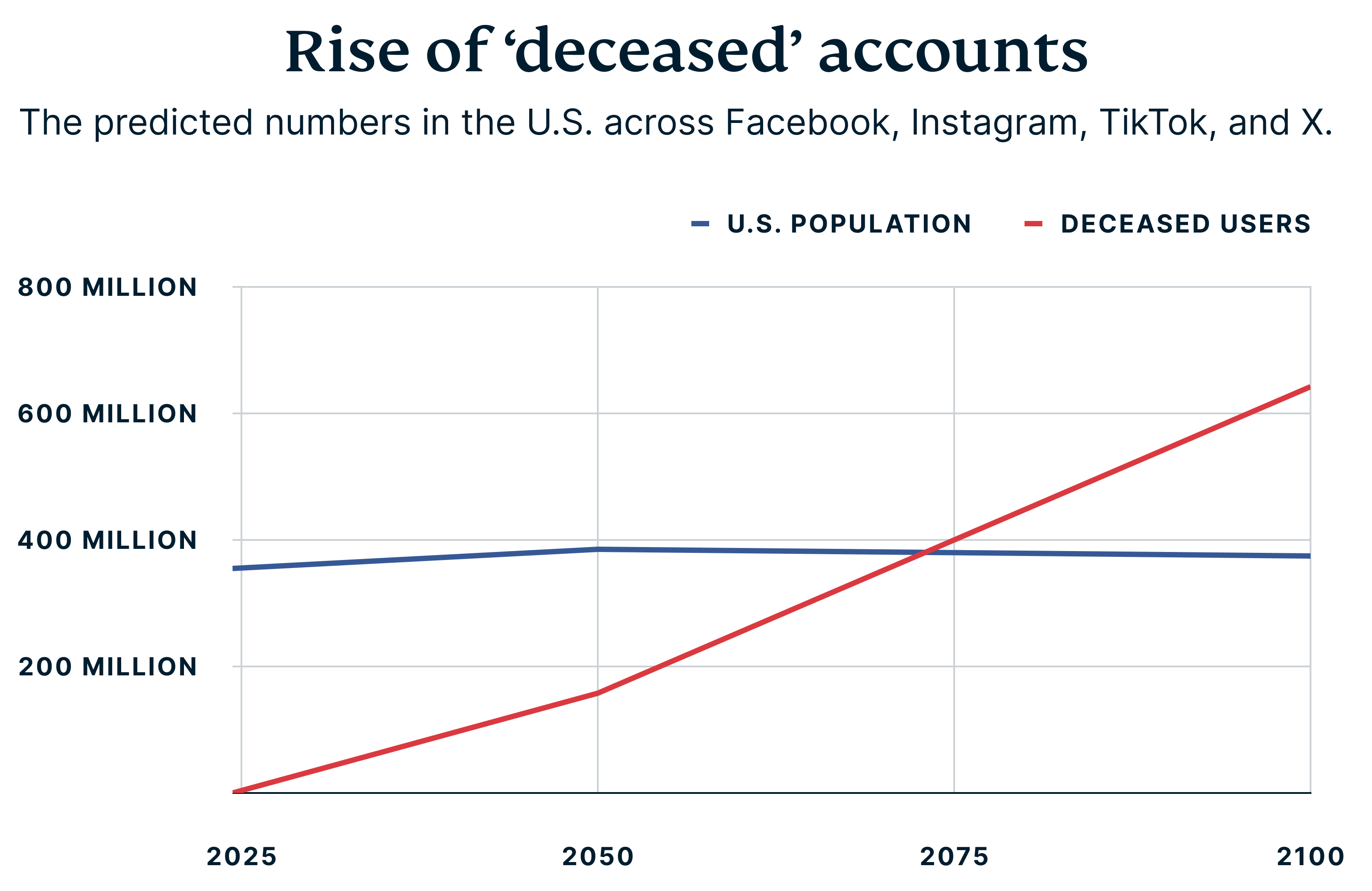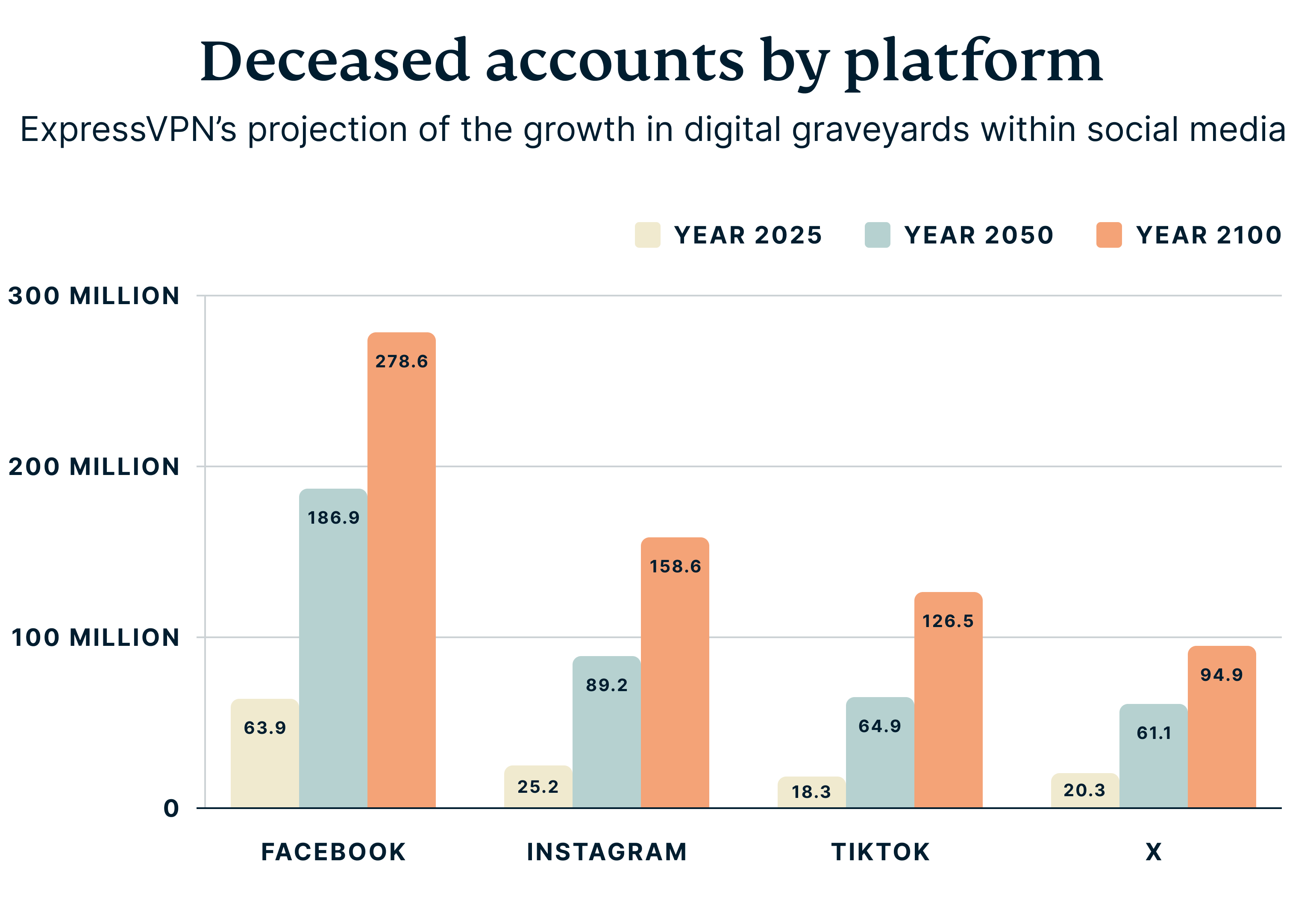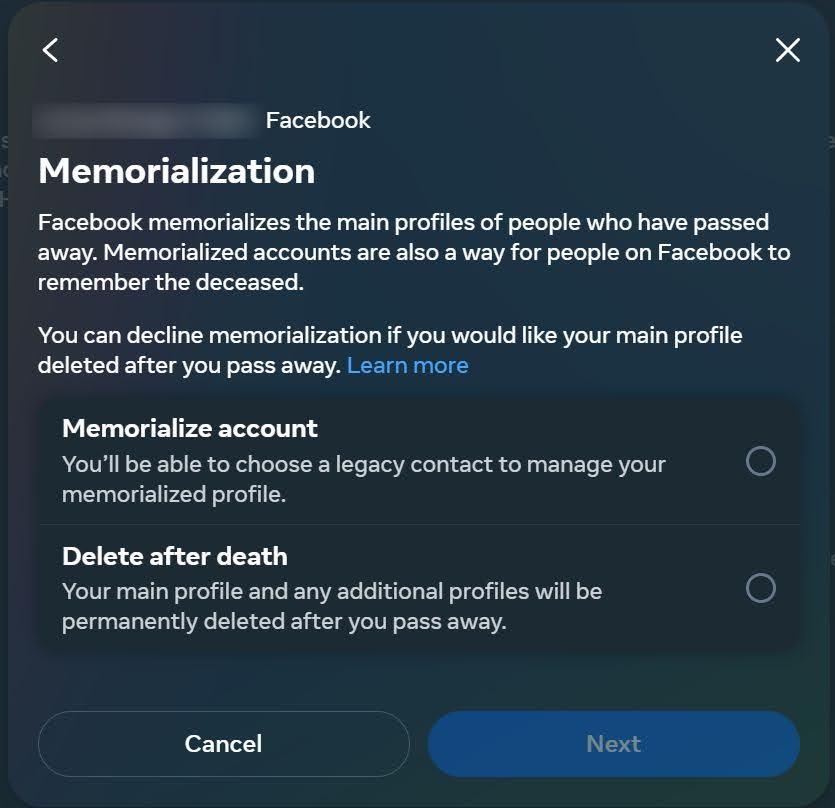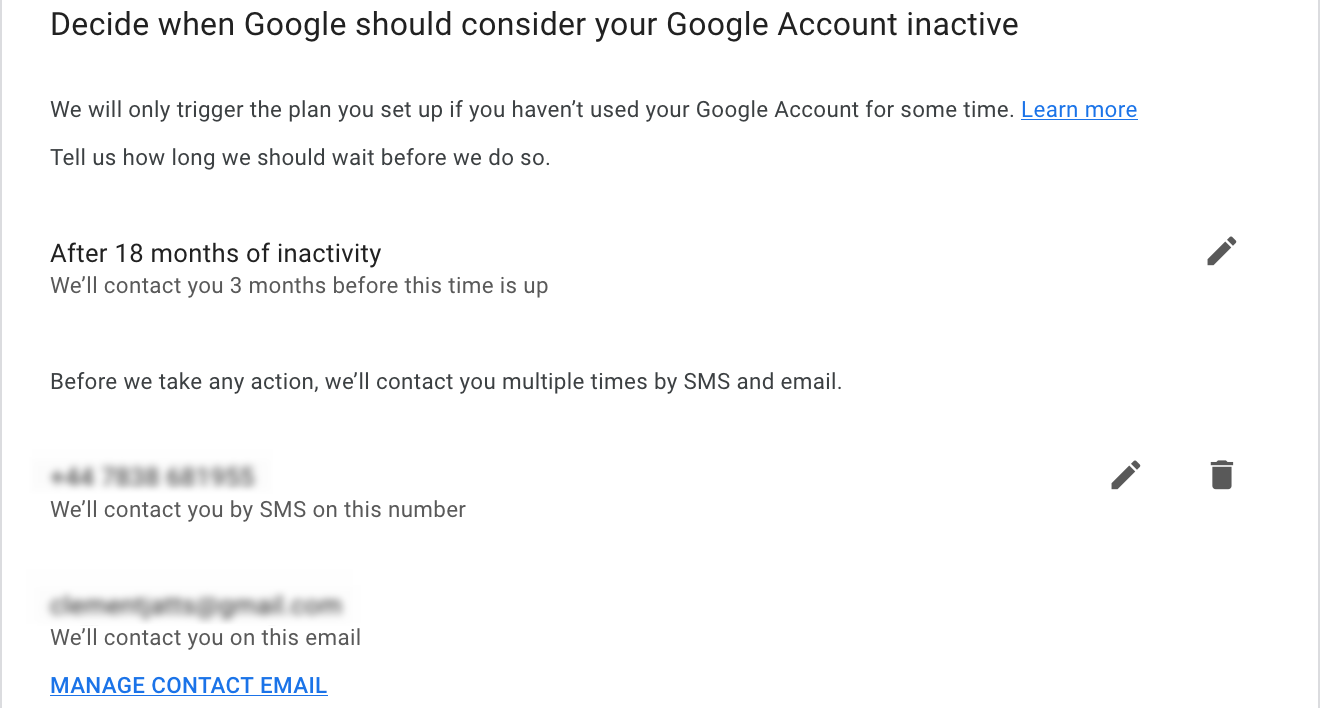- As social media has grown, so has the number of accounts belonging to deceased users, giving rise to the concept of “digital graveyards.”
n - ExpressVPN—a leading VPN service provider—has projected the number of such accounts across four social media platforms in various countries.
n - The U.S. figures stand out in particular, with 659 million deceased accounts expected by 2100, nearly double the size of the country’s population.
n - When it comes to maintaining deceased accounts, social media companies’ approaches are likely to evolve, as are societal attitudes.
n - This phenomenon underscores the benefits of making arrangements regarding one’s accounts following death, both to control your online legacy and protect your personal data.
It might seem morbid. But amid our digital age, almost everyone will leave behind a data legacy, whether it’s a collection of photos, email accounts, or social media posts.
Being able to conjure up memories online could be a comfort to loved ones. However, with roughly 5 billion people using social media worldwide, platforms filled with deceased accounts are fast becoming a reality. This raises broader questions about which countries will witness the largest growth of these digital graveyards, and what social media platforms plan to do about it.
ExpressVPN set out to explore this phenomenon, focusing on the future of digital legacies across four popular social media platforms in select countries. Our approach involved analyzing current user activity and mortality rates across different regions, using projections inspired by the methodology of a 2019 Oxford University study of a similar topic.
How big will digital graveyards get?
So how many accounts of deceased users are we talking about? We created some projections looking into the future.
Our analysis includes four leading social media platforms—Facebook, Instagram, X (formerly Twitter), and TikTok—to provide a detailed view of how accounts of the deceased are growing.
Focusing on eight countries (the U.S., UK, France, Germany, Spain, Italy, the Netherlands, and Portugal), we compare social media usage to population projections for 2024, 2050, and 2100.
This exploration into the afterlife of our online presences sheds light on the complexities and ethical considerations of managing digital legacies.
U.S. predicted to have the highest number of deceased social media users

In the U.S., the number of deceased social media users is projected to nearly double the country’s population by 2100, with 659 million deceased users overshadowing the predicted population of 366 million. This high figure reflects the U.S.’s high social media penetration rate and a continuously growing user base.
The table below shows the other countries, their predicted population growth, and predicted deceased accounts in 2050 and 2100.
| Country | Population 2024 | Social media users 2024 | Predicted population 2050 | Predicted deceased profiles 2050 | Predicted population 2100 | Predicted deceased profiles 2100 |
| U.S. | 341 million | 302 million | 388 million | 128 million | 366 million | 659 million |
| UK | 68 million | 56 million | 68 million | 20 million | 67 million | 70 million |
| Germany | 83 million | 68 million | 83 million | 16 million | 80 million | 111 million |
| France | 64 million | 54 million | 71 million | 15 million | 68 million | 106 million |
| Italy | 59 million | 43 million | 54 million | 12 million | 50 million | 88 million |
| Spain | 48 million | 41 million | 44 million | 11 million | 45 million | 82 million |
| Netherlands | 18 million | 15 million | 23 million | 5 million | 16 million | 31 million |
| Portugal | 10 million | 7 million | 9 million | 3 million | 7 million | 19 million |
The UK presents a slightly different case where deceased social media users are projected to match the living population by 2100, with both figures around 70 million. We arrived at this slower rate of increase, compared against the U.S., largely due to its lower rate of social media adoption.
Germany and France show similar patterns, with deceased users in 2100 projected to exceed the living populations by 31 million and 38 million, respectively. Both countries have relatively high social media usage and populations projected to change little.
Italy, Spain, the Netherlands, and Portugal’s deceased social media users are predicted to vastly outnumber the living by 2100. This phenomenon is particularly pronounced in Spain and Italy, with deceased users nearly double the living populations. Much of this finding is the result of the lower population growth rates expected for these countries.
Which platform will host the most digital legacies
Focusing on the U.S., the country with the largest social media user base, we analyze projections for deceased users across all four main social media platforms by the years 2050, 2075, and 2100. This analysis offers insight into which platforms will host the most digital legacies.

In the U.S., Facebook is projected to have the largest number of deceased accounts by 2100, with an estimated 278.6 million profiles belonging to users who have passed away. This large number reflects its large user base—making it also the primary repository of digital memorials.
With their smaller user bases, Instagram and TikTok will still have large numbers of deceased users, with projections of 158.7 million and 126.5 million, respectively, by 2100.
Lastly, X has a relatively low projection of 94.9 million deceased users by 2100, due to a small number of users and slowed growth since it changed ownership in 2022.
These projections raise questions about the management and ethical considerations of deceased accounts—especially in light of how much it costs social media giants to keep these platforms active.
The cost of hosting digital legacies
The prospect of social media platforms evolving into digital cemeteries brings with it not just emotional and ethical considerations but also financial implications.
Based on the assumption that an average social media profile requires 1GB of storage, with the cost of storage estimated at 0.02 USD per GB per month, maintaining the accounts of deceased individuals is already a considerable expense for social media companies.
With an estimated 278.6 million deceased Facebook users in the U.S. by 2100, the annual cost to store these profiles would reach about 67 million USD. This calculation assumes the storage cost remains constant, which is unlikely, but it highlights the potential financial burden on social media platforms in the future.
Realistically, it’s hard to imagine Facebook or any social media company being willing to maintain inactive accounts indefinitely. And the need to take down deceased accounts could lead to several phenomena:
New limits set by platforms
Social media platforms may be forced to rethink their policies. This could lead to the introduction of fees for maintaining a deceased user’s profile, limitations on the data stored, or even the deletion of profiles after a certain period of inactivity.
Alternative platforms for remembrance
Other ways to remember the deceased might arise. These could include decentralized digital memorials, blockchain-based solutions for eternal storage, or even AI-driven platforms that can generate interactive memorials without the need for extensive data storage.
Privacy and data protection
Personal information, even of the deceased, can be valuable to fraudsters. The need to safeguard the digital footprints of the deceased against unauthorized access and misuse of information is something that’s becoming increasingly recognized worldwide. The U.S. has made strides with the RUFADAA law, allowing individuals to designate a Trustee or Executor for their digital assets.
Preparing your digital legacy in advance
However, until such time that social media companies and regulatory frameworks offer clear and sustainable solutions for digital legacies, the responsibility falls on each of us to ensure our online presence is managed according to our wishes after we pass away.
Social media platforms have in place some settings and methods that you can use to designate what happens to your account in the event of your death.
Facebook provides users with two main options for their accounts posthumously: memorialization or deletion.
Memorialization
- What it is: A memorialized account becomes a space for friends and family to gather and share memories. The account is marked with “Remembering” next to the name and does not appear in public spaces like People You May Know.
- Legacy contact: You can appoint a Legacy Contact, someone you trust to manage your account once it’s memorialized. This person can pin posts, respond to new friend requests, and update profile and cover photos, but they won’t have access to your messages or be able to remove friends.
- How to set up: Go to Settings > select Memorialization Settings > Memorialization > Memorialize account and choose your legacy contact. Note: Only users over 18 can select a legacy contact.

Deletion
If you prefer not to have your account memorialized, you can opt for its complete deletion upon your passing. This ensures all your data, including posts and photos, are permanently erased once Facebook is notified of your death.
Following Facebook’s lead, Instagram—another platform under Meta’s umbrella—provides similar posthumous options for users’ accounts
Memorialization
- What it is: Memorialized accounts on Instagram display “Remembering” beside the user’s name, ensuring that their digital presence is preserved for friends and family. While these accounts retain their visibility, showing past posts to connected individuals, they are removed from public spaces like the Explore tab and friend suggestions.
- How it works: Unlike Facebook, Instagram does not currently offer a pre-selected legacy contact option. The process for memorialization happens posthumously, requiring friends or family to contact Instagram directly with the necessary documentation, such as an obituary or death certificate, to initiate the process.
Deletion
To have an account deleted, Instagram requires verification from a close family member. This process includes providing proof of authority (e.g., birth certificate, power of attorney) and evidence of the user’s passing. This ensures that the request is handled sensitively and in accordance with legal standards, permanently removing the user’s digital footprint from the platform.
X
Over the years, X has swung back and forth on whether it would introduce memorialized accounts. For many years, inactive accounts were allowed to sit dormant, including those of deceased people. However, in 2023, the platform started purging accounts with no activity. It was yet another controversial move under Elon Musk, as some people wanted to be able to continue to see the accounts of their late friends and family members.

Keeping an X account active posthumously
Since X doesn’t offer a system for memorializing accounts, if you wish to have your X account remain a part of the digital world after your passing, you need to take a proactive approach of giving someone your login details.
- Account access: Ensuring a family member or a trusted individual has your account login details is crucial. This detail can be included in your will or another secure method of sharing sensitive information. They’ll have to use your account regularly to keep it active.
- Full access considerations: Granting someone access to your account means they will see everything—messages, liked posts, and all aspects of your account. This level of access requires significant trust, as it exposes your private interactions and preferences.
X’s inactivity policy
At the time of writing, X’s stance categorizes an account as inactive if it hasn’t been used in the last 30 days, significantly tightening from its earlier six-month inactivity threshold. This policy necessitates regular logins to keep an account deemed active, posing a challenge for maintaining a digital legacy on the platform.
TikTok
For TikTok, a family member or legal representative can contact TikTok support with a death certificate to delete the account from the platform. So far, TikTok has not revealed if they’ll delete inactive accounts.
What you can do in advance
Like Twitter, all you can do if you don’t want your account to disappear is set up a safe way to share your account details with a trusted person. Remember the privacy implications with this choice.
Google and YouTube
Google provides a proactive tool, the Inactive Account Manager, for users to decide the fate of their accounts (including YouTube) after a period of inactivity. You can set this up to notify trusted contacts or delete your account after three, six, 12, or 18 months of inactivity. If you don’t set anything up, family members or legal representatives can request account closure posthumously with the necessary documentation.

Digital assets and subscription services
For digital assets not covered by specific platform policies, such as online shopping accounts and subscription services, the approach to managing these after death varies. To help prepare in advance:
- Compile a list: Document all your digital accounts, not just social media. Include online shopping accounts, subscription services, digital libraries, etc., along with your login details and instructions on handling them after your passing.
- Consider a digital will inclusion: Incorporate this list into a digital will or ensure a trusted individual has access to it.
- Enlist a direct contact for closure or transfer: The executor or a designated person can then approach each service with the required documentation, like a death certificate, to close accounts or transfer ownership as needed.
- Cancel subscriptions: If you’re getting your affairs in order, it would certainly be easier for your executor if you canceled some subscriptions while you’re still living.
Methodology
Our methodology integrates current platform user metrics with national mortality rates, applying a predictive model inspired by the study Are the dead taking over Facebook? A Big Data approach to the future of death online by the Oxford Internet Institute (OII).
- Data gathering: We used available data on monthly active users for each social media platform. Mortality rates were sourced from national statistics databases.
- Predictive model application: We created a predictive model (similar to the one in OII’s study) to estimate the number of deceased accounts based on current user activity and mortality rates.
- Assumptions: The user base for each social media platform and the mortality rates of each country are assumed to remain constant over the forecast period, starting from 2024. Policies on inactive accounts, such as X’s profile removal, are acknowledged but not adjusted for.
- Limitations: We recognize the inherent uncertainties in projecting long-term social media trends, including changes in platform popularity, user behavior, and population longevity.
FAQ: Social media after death
What happens to your data when you die?
Much of your online material like social media or email accounts will likely remain intact for years, unless platforms are informed that you’ve died and are instructed to close them. Some of the companies will have policies of removing accounts due to a period of inactivity.
As for your data, social media companies claim to permanently delete all data, apart from some anonymized logs, with an account’s closure. Some platforms, like Google, can provide content from a deceased user’s account. But sites generally would not give anyone access to private information like messages you’ve sent or your passwords
What happens to my social media accounts if I don’t specify my wishes before I die?
Depending on the social media platform in question, you’ll have to rely on a family member to contact the service with proof of death. They’ll then either be able to memorialize the account like with Facebook and Instagram or delete it.
If nothing is done, the account may be frozen and eventually deleted after a period of complete inactivity. Twitter has already started doing this for long-dormant accounts.
Can I appoint someone to manage my social media accounts after I pass away?
Yes, Facebook and Instagram allow you to set a “legacy contact” who will be in charge of your memorialized account. This lets them change photos on the account, manage tribute posts, and accept friend requests. However, your private data will remain private, including your messages and other account activity.
Leaving login information behind for someone via your will is also possible. However, giving full access to your accounts this way comes with some privacy concerns, since many account functions aren’t gated like when using a legacy contact.
Are there services or professionals who can assist in managing digital legacies?
Yes, an estate lawyer is likely to have knowledge about handling digital assets. Digital legacy services and consultants also offer services like online safety deposit boxes and legacy planning tools.
Is it worth keeping the accounts of deceased individuals?
If the deceased did not leave instructions regarding their accounts, there are a few factors for executors to consider.
A memorialized social media account could be visited by grieving loved ones, and any photos or information posted publicly could still be seen by visitors hoping to retrieve some memories.
However, any public presence could still pose some privacy concerns. Scammers might try to impersonate the deceased, for instance, if they learn about the death through a memorialized page.
With these factors in mind, it might be worth keeping public accounts for a certain time period before taking them down entirely.
What can I do if I don’t want my social media accounts closed after I die?
If you don’t want to close your social media accounts, there are several things you can do instead.
Leaving login information for someone via your will to manage your digital legacy is possible. However, giving full access to your accounts can raise privacy concerns, as many account functions are not gated. To handle digital assets as part of your will, it is best to consult a professional specializing in this field, such as an estate lawyer.
Digital legacy services and consultants can offer online safety deposit boxes and legacy planning tools. The decision to keep the accounts of deceased individuals active depends on several factors, such as the deceased’s wishes and the effort it takes for their loved ones.
Some social media platforms offer the option to “memorialize” accounts, but it may not suit everyone’s preferences or may not have been considered beforehand. Leaving social media accounts active after someone dies can lead to privacy concerns, emotional distress, and legal/ethical dilemmas. Therefore, it is essential to have clear instructions for who should control or access these accounts.



![[Quiz] How much is your data worth on the dark web? how much are you worth on the dark web (1)](https://s22908.pcdn.co/wp-content/uploads/2023/04/how-much-are-you-worth-on-the-dark-web-1-1-100x70.jpg)





















